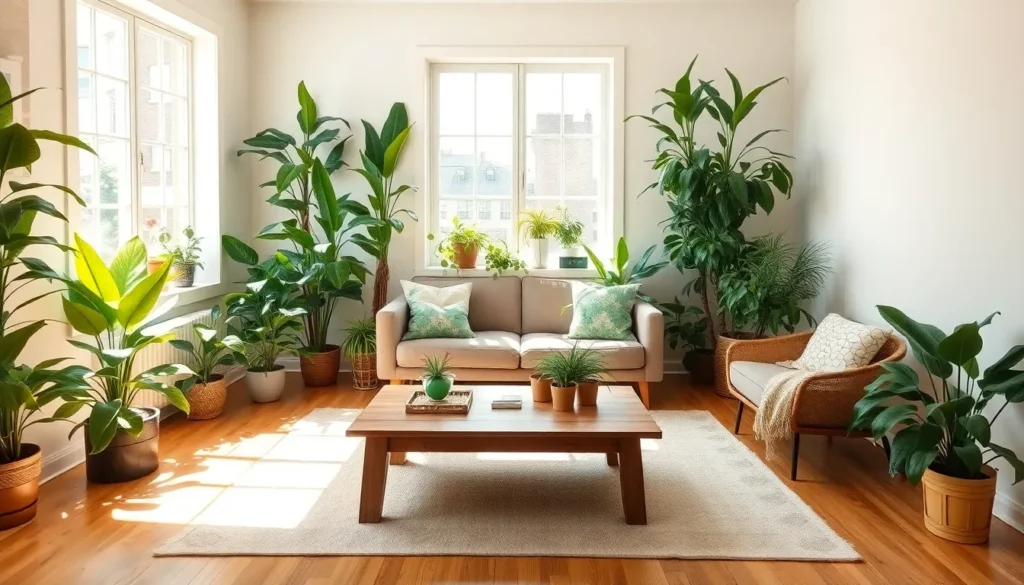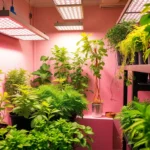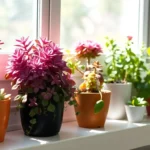We’ve all heard about the dangers of outdoor air pollution but what about the air we breathe inside our homes? Most of us spend 90% of our time indoors yet indoor air can be 2-5 times more polluted than outdoor air. The good news? Nature offers us a beautiful and cost-effective solution that’s been hiding in plain sight.
Air purifying houseplants aren’t just trendy Instagram props – they’re powerful natural air filters that can transform your living space into a healthier sanctuary. These green warriors work around the clock to remove harmful toxins like formaldehyde benzene and carbon monoxide while pumping fresh oxygen back into your home.
We’re about to explore the science-backed benefits of these remarkable plants and reveal which varieties deliver the biggest impact for your health and home. From low-maintenance options perfect for beginners to statement plants that double as stunning décor you’ll discover how easy it is to breathe cleaner air naturally.
Top Air Purifying House Plants for Cleaner Indoor Air
We’ve identified three powerhouse plants that consistently rank highest for air purification based on NASA’s Clean Air Study. Each of these natural air filters brings unique benefits to your indoor environment.
Snake Plant (Sansevieria Trifasciata)
Snake plants excel at removing formaldehyde, xylene, and toluene from indoor air while producing oxygen at night. These hardy succulents thrive in low light conditions and require minimal watering, making them perfect for beginners. We recommend placing snake plants in bedrooms since they continue purifying air during nighttime hours when most plants stop producing oxygen.
Key benefits include:
- Removes 4-5 common household toxins
- Tolerates neglect and low light environments
- Requires watering only every 2-3 weeks
- Grows up to 4 feet tall for maximum air cleaning coverage
Peace Lily (Spathiphyllum)
Peace lilies filter out ammonia, benzene, formaldehyde, and trichloroethylene from your living space. These elegant flowering plants signal when they need water by drooping their leaves, eliminating guesswork in plant care. We’ve found peace lilies particularly effective in bathrooms and kitchens where humidity levels support their tropical nature.
Notable features:
- Removes 5 major indoor air pollutants
- Produces beautiful white blooms year round
- Thrives in medium to low light conditions
- Acts as a natural humidity indicator
Spider Plant (Chlorophytum Comosum)
Spider plants absorb formaldehyde and xylene while being completely safe around pets and children. Their cascading baby plantlets create natural air purification networks throughout your home as they mature. We suggest hanging spider plants in areas with moderate light to showcase their trailing growth pattern and maximize air cleaning potential.
- Non toxic to pets and children
- Produces baby plants for easy propagation
- Adapts to various lighting conditions
- Filters air pollutants within 24 hours of placement
Best Air Purifying House Plants for Beginners
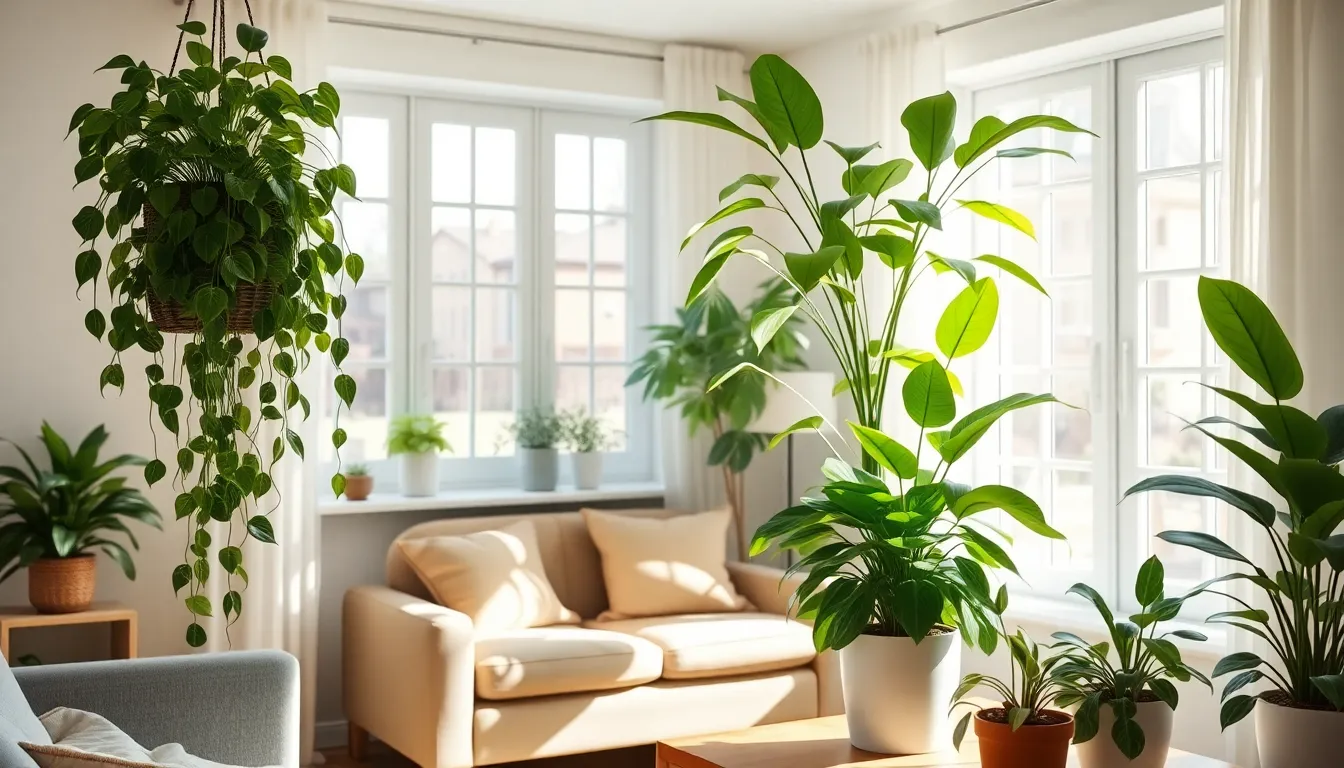
We’ve carefully selected three air purifying plants that combine exceptional toxin removal capabilities with beginner friendly care requirements.
Pothos (Epipremnum Aureum)
Pothos stands out as one of the most effective air purifying plants for novice gardeners. This versatile houseplant, commonly known as golden pothos or devil’s ivy, excels at removing four major indoor air toxins: xylene, carbon monoxide, formaldehyde, and benzene. NASA research confirms its exceptional air cleaning abilities, making it a top choice for improving indoor air quality.
Growing pothos requires minimal experience since it thrives in various light conditions from low to bright indirect sunlight. Care involves watering only when the soil feels dry and occasional trimming to manage its trailing growth. The plant features attractive heart shaped leaves that can reach up to 20 inches in length, creating an impressive display whether placed in hanging baskets or tabletop containers.
Rubber Plant (Ficus Elastica)
Rubber plants earn recognition from both NASA and plant care experts as top tier air purifiers. These robust houseplants feature large, glossy leaves that effectively filter airborne toxins while tolerating the varied conditions found in most homes. Their impressive ability to improve indoor air quality makes them particularly valuable for beginners seeking reliable air purification.
Maintenance stays simple with rubber plants since they adapt well to moderate indoor lighting and standard watering schedules. Water your rubber plant when the topsoil feels dry to the touch, typically every 1-2 weeks depending on your home’s humidity levels. Their sturdy nature and tolerance for occasional care mistakes make them forgiving companions for new plant owners.
ZZ Plant (Zamioculcas Zamiifolia)
ZZ plants excel in low light environments where other air purifying plants might struggle. These remarkable houseplants remove three important indoor pollutants: benzene, toluene, and xylene, while requiring virtually no maintenance experience. Their thick, waxy leaves store water efficiently, making them incredibly drought tolerant and perfect for busy beginners.
Care requirements remain minimal since ZZ plants thrive with infrequent watering and indirect sunlight exposure. Water your ZZ plant only when the soil completely dries out, which might occur just once every 2-3 weeks. This exceptional tolerance for neglect, combined with effective air purification capabilities, makes ZZ plants ideal for anyone starting their journey with air purifying houseplants.
Low-Light Air Purifying House Plants for Dark Spaces
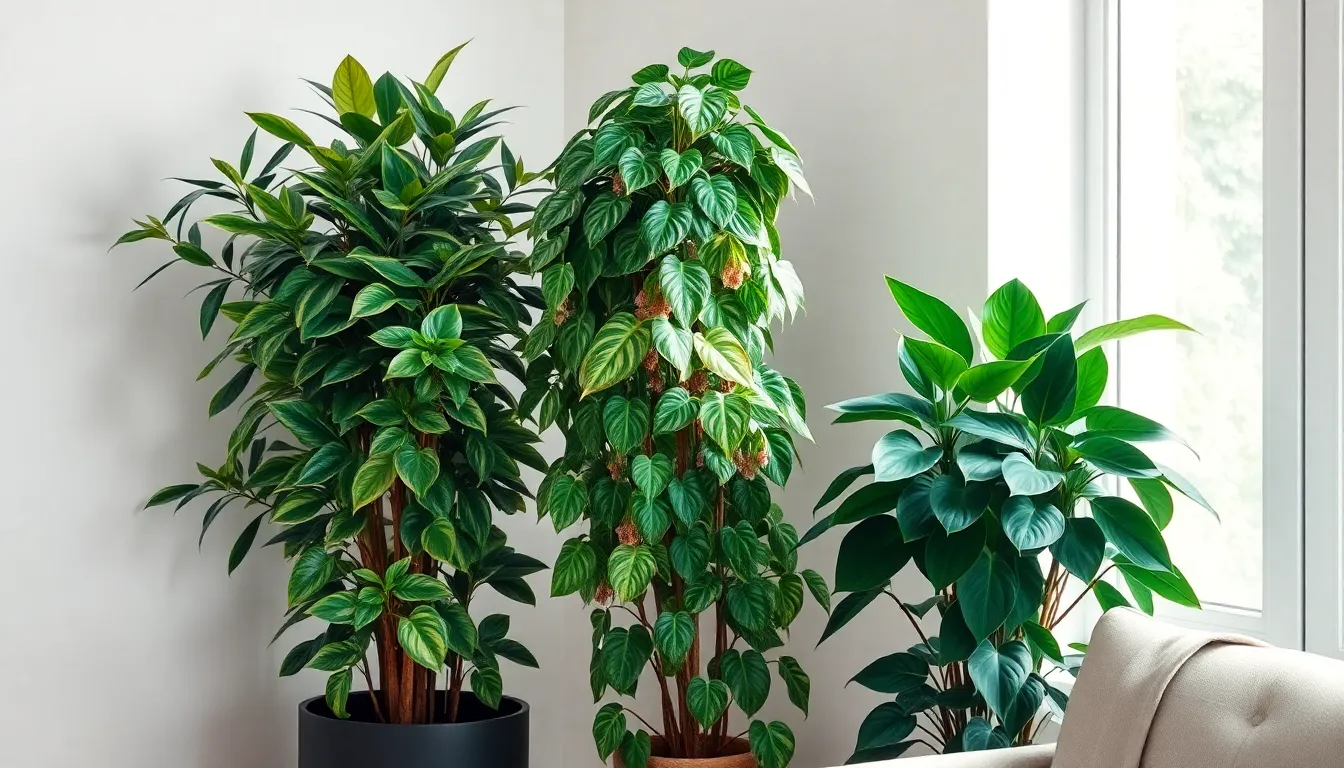
Dark corners and windowless rooms don’t have to compromise your air quality goals. We’ve identified three exceptional plants that thrive in low light conditions while actively filtering harmful pollutants from your indoor environment.
Chinese Evergreen (Aglaonema)
Chinese Evergreen stands out as one of our top recommendations for removing formaldehyde and benzene from household air. These common indoor pollutants often originate from furniture, cleaning products, and synthetic materials throughout your home. The plant’s striking variegated leaves add visual appeal while working continuously to clean your air.
Thriving in low to moderate light makes this plant perfect for darker spaces like hallways, offices, or bedrooms with limited natural sunlight. We appreciate its low maintenance requirements and exceptional tolerance for poor lighting conditions. Moderate watering every 1-2 weeks keeps this hardy plant healthy and actively purifying your air.
Positioning your Chinese Evergreen near areas where you spend important time maximizes its air cleaning benefits. The plant’s resilience means it’ll continue filtering pollutants even if you occasionally forget to water it.
Philodendron
Philodendrons excel at filtering formaldehyde from indoor air, making them valuable additions to any low light space. Their heart shaped leaves create an attractive cascading effect while absorbing harmful chemicals commonly found in household products and building materials.
Adapting well to dim environments, these plants prefer low to indirect light rather than bright sunshine. We recommend placing them in corners, on shelves, or in rooms with north facing windows where direct sunlight is minimal. Their trailing vines make them excellent choices for hanging baskets or high shelves in darker areas.
Caring for philodendrons requires only moderate watering and basic attention to their growing conditions. They’re known for their resilience in challenging indoor environments and continue purifying air even when lighting conditions aren’t ideal.
Cast Iron Plant (Aspidistra Elatior)
Cast Iron Plant earns its name from incredible durability and ability to absorb indoor pollutants while tolerating extreme neglect. This robust plant handles very low light conditions better than almost any other air purifying variety we recommend.
Tolerating dark or heavily shaded indoor areas makes this plant perfect for spaces like basements, interior bathrooms, or rooms without windows. We value its reputation for surviving in conditions where other plants would struggle or fail completely. The plant’s slow growth means it won’t outgrow its space quickly.
Requiring minimal care and infrequent watering, Cast Iron Plant suits busy lifestyles and those new to plant care. Water it only when the soil feels completely dry, typically every 2-3 weeks depending on your home’s humidity levels.
| Plant | Light Tolerance | Pollutants Removed | Watering Frequency | Difficulty Level |
|---|---|---|---|---|
| Chinese Evergreen | Low to moderate | Formaldehyde, benzene | Every 1-2 weeks | Easy |
| Philodendron | Low to indirect | Formaldehyde | Moderate watering | Easy |
| Cast Iron Plant | Very low | General indoor pollutants | Every 2-3 weeks | Very easy |
Air Purifying House Plants That Remove Specific Toxins
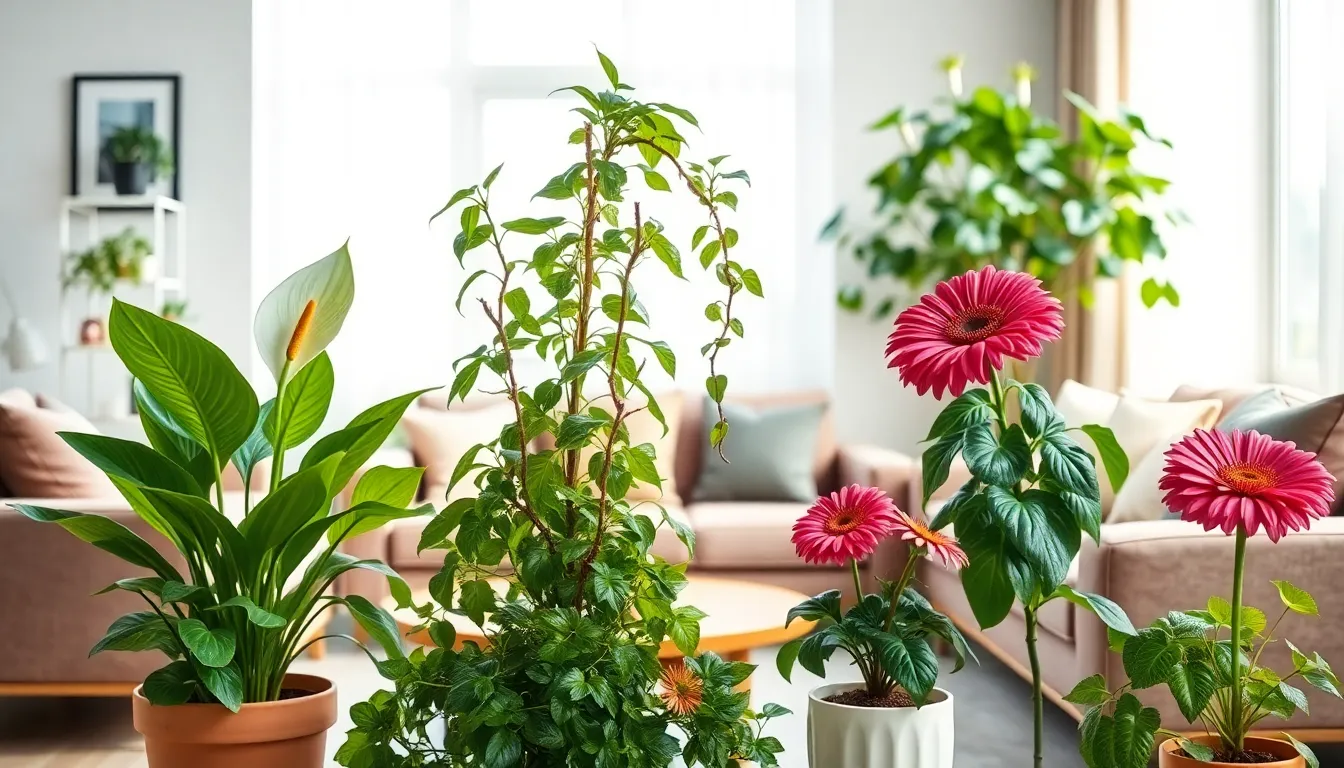
We’ve explored various air purifying plants, but understanding which exact toxins they target helps us make more informed choices for our homes. Different plants excel at filtering different harmful compounds from our indoor air.
Formaldehyde-Fighting Plants
Peace Lily stands out as one of the most effective formaldehyde fighters in our homes. This elegant plant removes formaldehyde emissions from building materials, furniture, and cleaning agents while adding beautiful white blooms to our spaces. We’ll find that peace lilies thrive in humid environments like bathrooms and kitchens where formaldehyde levels often run higher.
Spider Plant offers another reliable option for formaldehyde removal, especially in homes with children and pets. These safe, easy care plants absorb formaldehyde from synthetic materials while producing baby plants that multiply our air cleaning power. We can place spider plants throughout our homes to target formaldehyde sources like pressed wood furniture and carpeting.
Benzene-Busting Varieties
English Ivy demonstrates strong benzene absorption capabilities in controlled environments, making it valuable for homes with paint fumes or tobacco smoke exposure. This trailing plant works well in hanging baskets or as ground cover, though we should note that real industry effectiveness differs from laboratory conditions. We’ll want to position English ivy near potential benzene sources like garages or create rooms.
Gerbera Daisy provides colorful benzene filtering power with its bright blooms and active foliage. Studies initially showed this flowering plant could absorb benzene from synthetic materials and paint, though achieving meaningful results requires multiple plants in concentrated areas. We can use gerbera daisies to add both beauty and potential air cleaning benefits to sunny windowsills.
Ammonia Absorbers
Plants that absorb ammonia show promise in laboratory settings, though exact species data remains limited for real industry applications. Cleaning products and household chemicals release ammonia that can irritate our respiratory systems, making these plants theoretically valuable additions to our homes. We should understand that current research hasn’t identified which exact houseplants most effectively remove ammonia in typical indoor environments.
Practical ammonia reduction through plants requires understanding their limitations compared to proper ventilation systems. While some plants reportedly absorb ammonia compounds, achieving important removal would require an unrealistically high plant density of 10 to 1,000 plants per square meter. We’re better served by improving ventilation and reducing ammonia containing products rather than relying solely on plants for this exact toxin removal.
Large Air Purifying House Plants for Maximum Impact
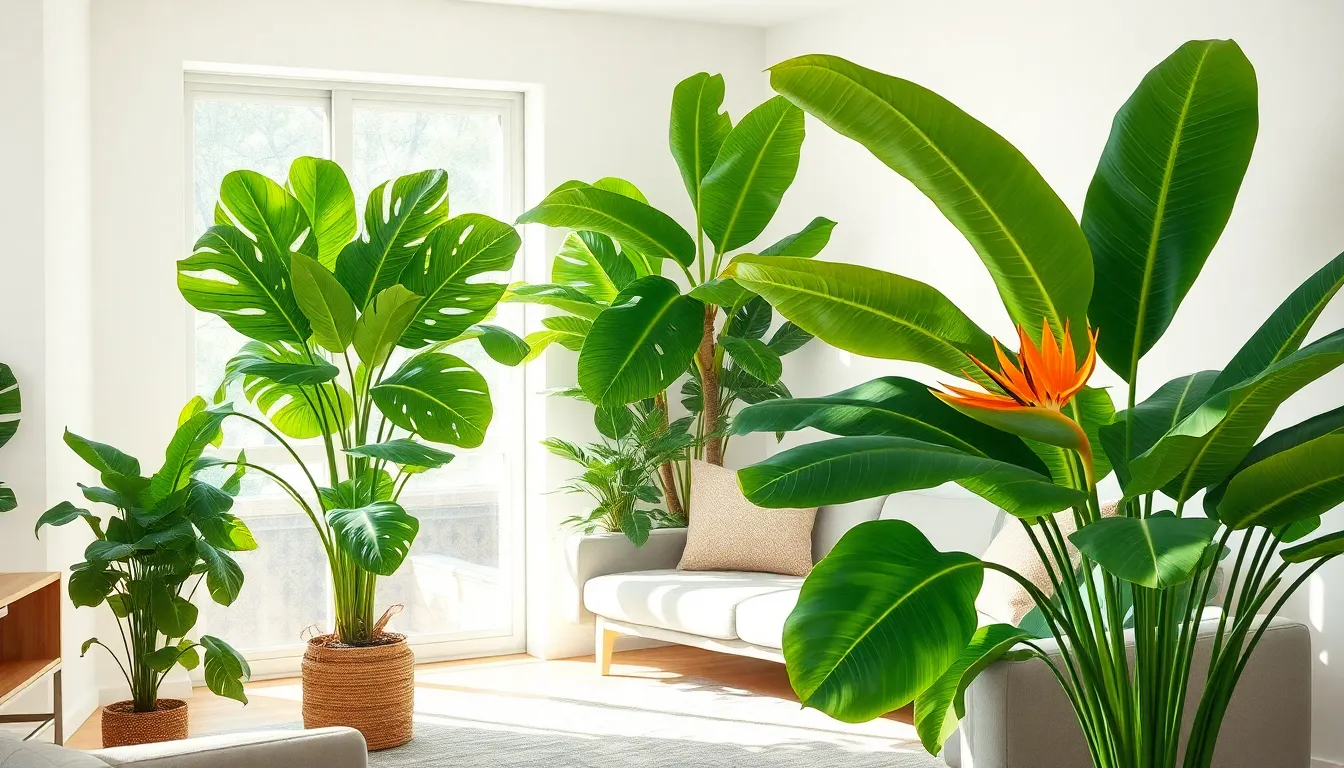
Large leafy plants take air purification to the next level with their expansive surface area and impressive toxin absorption capabilities. We’ve identified three stunning specimens that combine maximum air cleaning potential with dramatic visual impact for your home.
Fiddle Leaf Fig (Ficus Lyrata)
Fiddle Leaf Fig delivers exceptional air purification through its broad, glossy leaves that actively remove formaldehyde and benzene from indoor environments. While not featured in NASA’s original study, this popular houseplant belongs to the Ficus family, which includes proven air purifiers like the Rubber Plant that effectively eliminate airborne toxins.
Large surface area of each leaf maximizes the plant’s ability to absorb volatile organic compounds through its foliage and root system. Formaldehyde and benzene removal occurs continuously as the plant processes these common household pollutants found in furniture, cleaning products, and adhesives.
Indoor air quality improves significantly when we place this statement plant in living rooms or bedrooms where its impressive height and leaf span create maximum filtration coverage. Care requirements include bright, indirect light and consistent watering to maintain optimal air cleaning performance.
Monstera Deliciosa
Monstera Deliciosa excels at improving indoor air quality with its distinctive perforated leaves that create extensive surface area for absorbing volatile organic compounds. This tropical beauty effectively filters formaldehyde and benzene from household air while adding dramatic architectural interest to any space.
Broad leaf structure enables superior pollutant absorption compared to smaller plants, with each mature specimen capable of processing important amounts of airborne toxins. Large fenestrations in the leaves don’t reduce the plant’s air purifying abilities but actually increase air circulation around the foliage.
Tropical origins make this plant particularly effective at handling humid indoor conditions while maintaining consistent air filtration performance. Growth patterns allow the plant to expand its air cleaning capacity over time as new leaves develop and mature.
Bird of Paradise (Strelitzia Reginae)
Bird of Paradise provides impressive air purification potential through its large banana shaped leaves that can absorb common indoor air pollutants. While exact research on this species remains limited, the extensive leaf surface area creates important opportunities for toxin absorption similar to other tropical plants.
Large foliage mass allows for substantial contact with indoor air, facilitating the removal of household chemicals and volatile organic compounds. Tropical plant characteristics suggest effectiveness against formaldehyde and benzene, which are frequently found in home environments.
Indoor placement near windows maximizes both the plant’s air cleaning abilities and its stunning visual impact when mature specimens produce their signature orange and blue flowers. Care involves providing bright light and maintaining proper humidity levels to support optimal air purification performance.
Pet-Safe Air Purifying House Plants for Animal Lovers
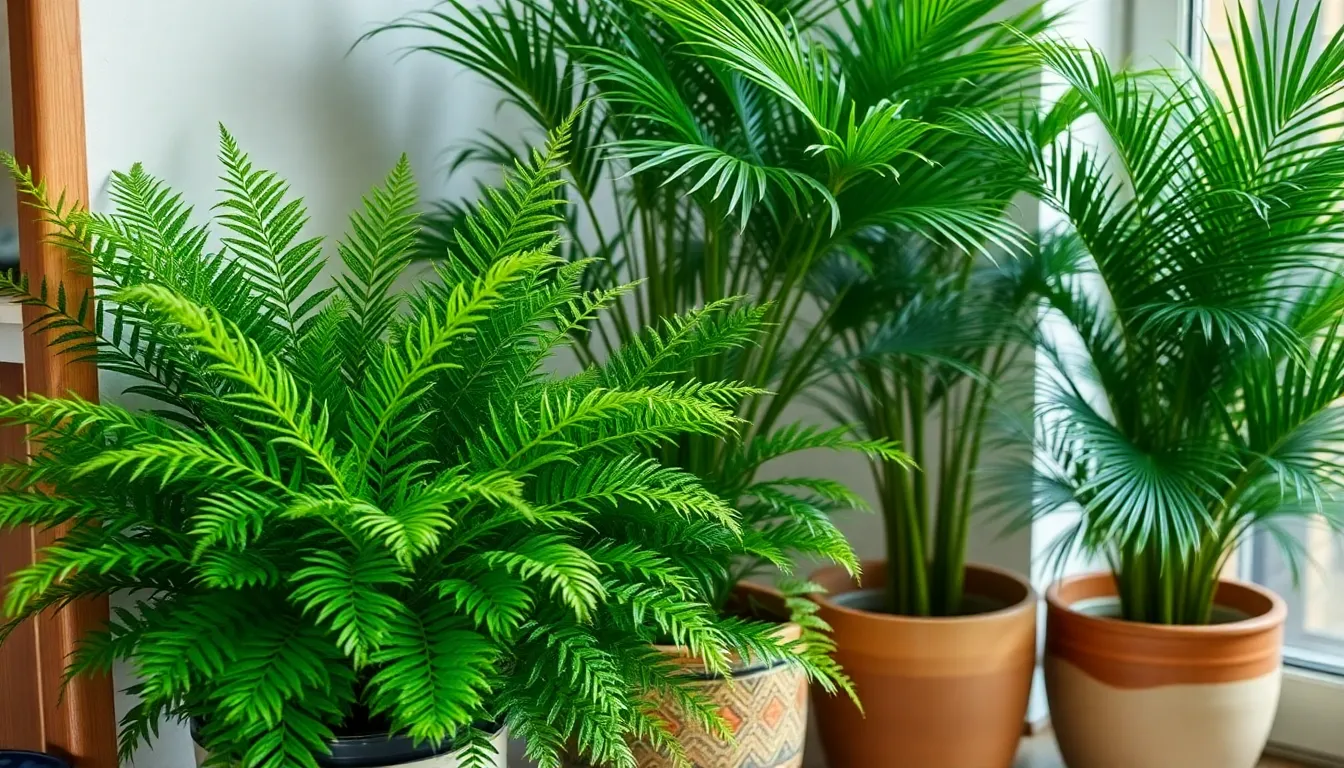
We understand that pet owners need to be extra cautious when selecting houseplants for their homes. Fortunately, several air purifying species are completely safe for our furry friends while still providing valuable indoor air quality benefits.
Boston Fern (Nephrolepis Exaltata)
Boston Ferns offer lush, feathery fronds that create a natural air cleaning system perfect for pet owners. This plant helps increase humidity levels while reducing airborne toxins, making it an excellent choice for homes with cats and dogs. We love how Boston Ferns add a tropical feel to any room while remaining completely non-toxic to pets.
The plant’s moderate air cleaning capabilities work through natural biological processes, helping to filter out common household pollutants. Boston Ferns thrive in indirect light and humid conditions, making bathrooms and kitchens ideal locations. Their cascading fronds create beautiful displays in hanging baskets, keeping them safely out of reach from curious pets.
Bamboo Palm (Chamaedorea Seifrizii)
Bamboo Palms excel at filtering benzene and formaldehyde from indoor air while maintaining complete safety around pets. These elegant palms add moisture to dry indoor environments, which benefits both respiratory health and overall comfort. We appreciate how Bamboo Palms create a calming, tropical atmosphere that pets and humans both enjoy.
The plant’s air purifying abilities stem from its efficient absorption of volatile organic compounds through its leaves and root system. Bamboo Palms prefer bright, indirect light and consistent watering, making them relatively easy to maintain. Their upright growth pattern makes them perfect floor plants that won’t tempt pets to nibble on hanging foliage.
Areca Palm (Dypsis Lutescens)
Areca Palms, also known as butterfly palms, serve as gentle air purifiers that are completely safe for pets. This popular houseplant has a high transpiration rate, helping to humidify indoor air naturally while filtering out common toxins. We find Areca Palms particularly valuable for their ability to add both beauty and air quality benefits to pet friendly homes.
The plant’s feathery, arching fronds create an elegant focal point while working to remove airborne pollutants through photosynthesis and transpiration. Areca Palms thrive in bright, indirect light and require regular watering to maintain their lush appearance. Their non-toxic nature means pet owners can enjoy improved air quality without worrying about their animals’ safety.
Flowering Air Purifying House Plants for Added Beauty
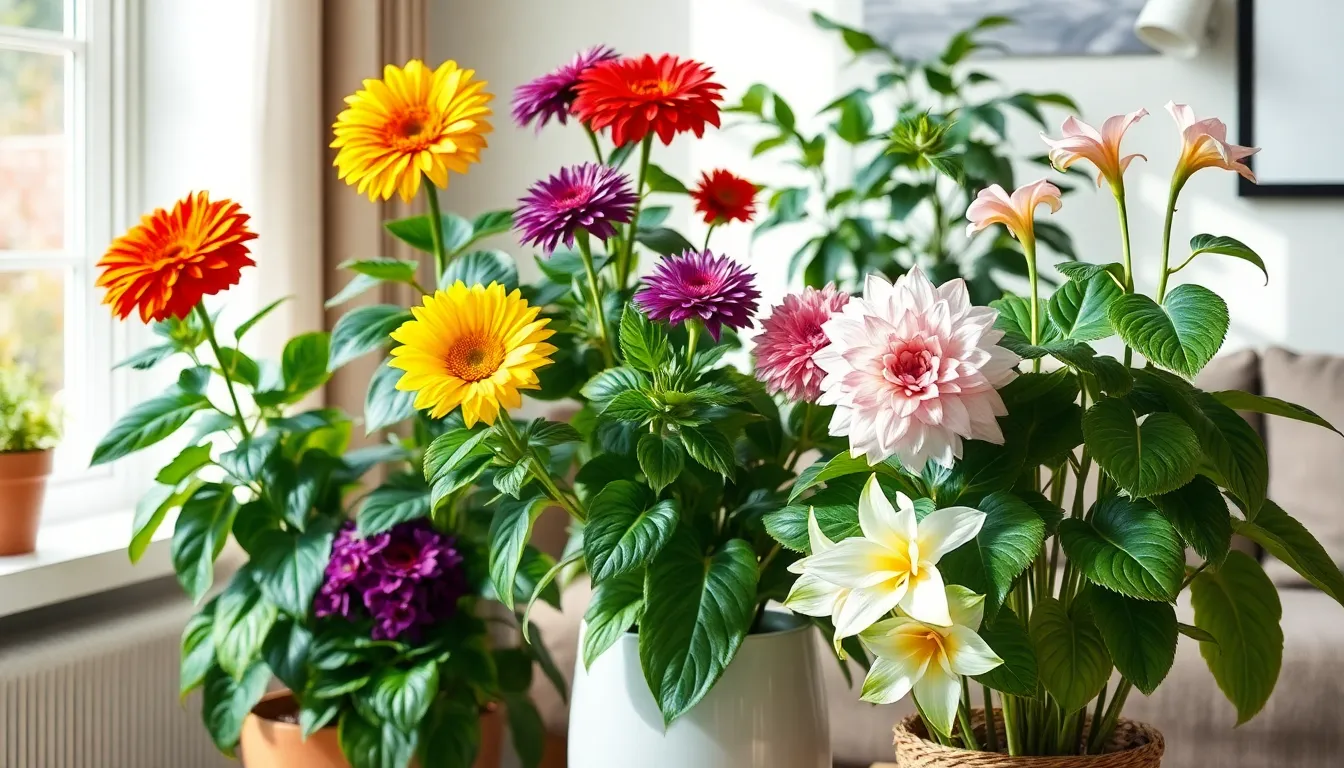
While we’ve explored various foliage plants for air purification, flowering varieties offer the perfect combination of toxin removal and visual appeal. These blooming beauties add vibrant colors to our living spaces while contributing to cleaner indoor air.
Gerbera Daisy (Gerbera Jamesonii)
Gerbera daisies bring bright, cheerful blooms in colors ranging from yellow and orange to pink and red while offering VOC absorption capabilities. NASA’s research recognizes these flowering plants for their ability to remove benzene, formaldehyde, and trichloroethylene from indoor air. We love how these compact plants thrive in sunny locations like windowsills and bright living rooms where they can showcase their large, colorful flower heads.
Care for gerbera daisies requires well-draining soil and regular watering to keep the soil consistently moist. These plants prefer temperatures between 65-75°F and benefit from removing spent blooms to encourage continuous flowering. Their relatively small size makes them perfect for tabletops, desks, or kitchen counters where we need both beauty and air purification.
Chrysanthemum (Chrysanthemum Morifolium)
Chrysanthemums excel at removing benzene, formaldehyde, and other toxins according to NASA’s Clean Air Study findings. These versatile flowering plants produce blooms in autumn shades of yellow, bronze, purple, and white that complement seasonal decor. We appreciate how mums can serve as both indoor houseplants and outdoor garden additions depending on our needs.
Indoor chrysanthemums require bright, indirect light and cool temperatures around 60-65°F to maintain their blooms longer. Water these plants when the top inch of soil feels dry, ensuring good drainage to prevent root rot. Their compact growth habit works well in medium-sized pots placed near east or west-facing windows where they receive gentle morning or afternoon light.
Flamingo Flower (Anthurium Andraeanum)
Flamingo flowers attract attention with their glossy, heart-shaped leaves and bright red, pink, or white spathes that last for months. These tropical beauties reduce indoor pollutants including ammonia, formaldehyde, and xylene while adding exotic flair to our homes. We find their waxy, colorful bracts create stunning focal points in living rooms, bedrooms, or office spaces.
Anthurium plants thrive in warm, humid conditions with temperatures between 70-85°F and humidity levels above 50%. Place these flowering air purifiers in bright, filtered light away from direct sun which can scorch their leaves. Water when the top inch of soil becomes dry, and mist regularly or use a humidity tray to maintain the moisture levels these tropical plants crave.
Care Tips for Maintaining Your Air Purifying House Plants
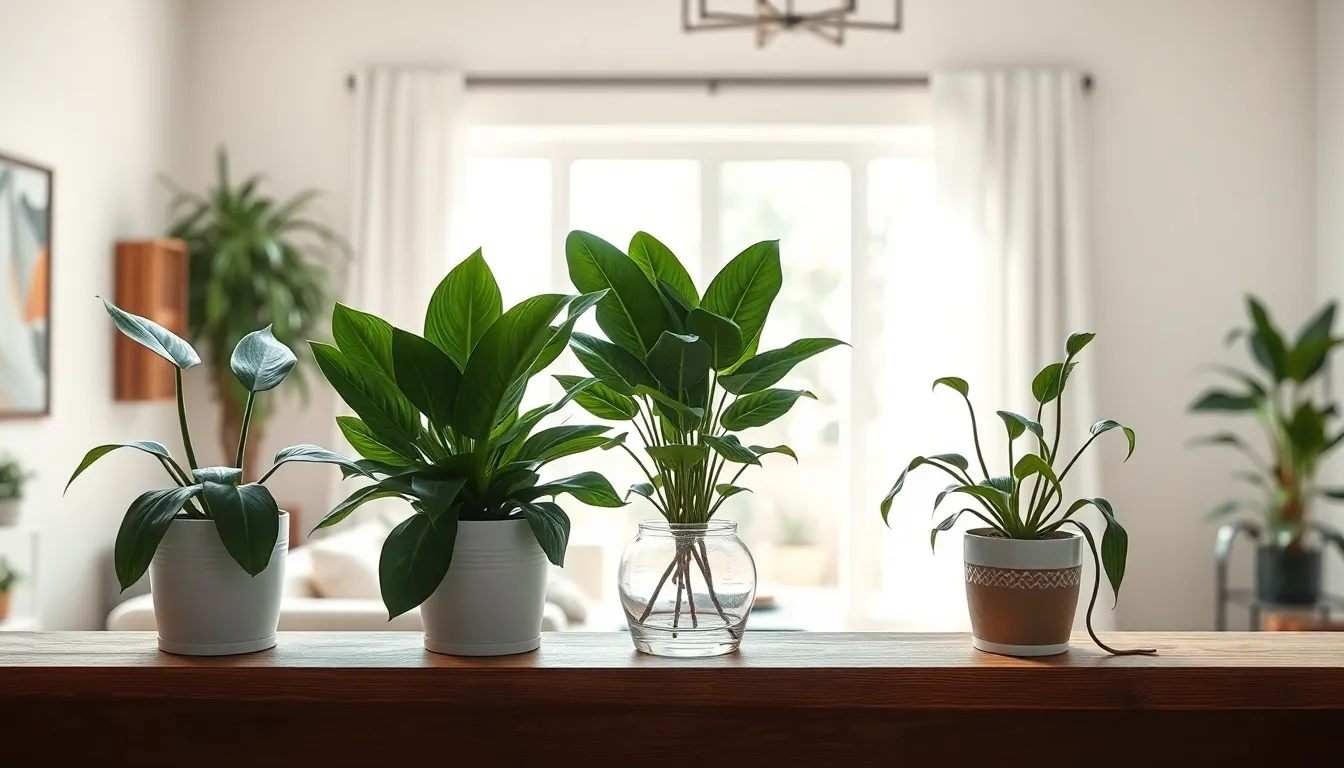
Proper care ensures our air purifying plants continue removing toxins while thriving in our homes. Understanding each plant’s exact needs helps maximize their air cleaning potential.
Proper Watering Techniques
Watering according to individual plant needs prevents the most common care mistake we encounter. Most air purifying plants like Peace Lily, Spider Plant, and Pothos prefer soil that stays moist but never soggy.
Testing the top inch of soil before watering helps us avoid overwatering, which leads to dangerous root rot. We should let this surface layer dry out completely before adding more water, except for tropical varieties like Boston Fern that need consistently moist conditions.
Room temperature water protects our plants from shock that can stress their systems. Cold water straight from the tap can damage roots and slow down the toxin absorption process that makes these plants so valuable.
Drainage becomes critical since standing water kills more houseplants than drought conditions. We need pots with drainage holes and saucers that we empty within 30 minutes of watering.
Light Requirements
Light needs vary dramatically among our air purifying plant collection, making proper placement essential for healthy growth. Peace Lily and Pothos thrive in low to medium indirect light, making them perfect for interior rooms away from windows.
Bright indirect light suits plants like Aloe Vera and Rubber Plant that need more energy for photosynthesis. We should place these varieties near east or west facing windows where they receive filtered sunlight throughout the day.
Filtered light works best for Dracaena species, though they tolerate lower light conditions when necessary. These adaptable plants can survive in office environments with artificial lighting.
Direct sunlight damages shade loving plants by scorching their leaves and reducing their air purifying effectiveness. We must avoid placing plants like Chinese Evergreen or Cast Iron Plant in south facing windows with harsh afternoon sun.
Common Maintenance Mistakes
Overwatering causes yellowing leaves and wilting that many people mistake for underwatering, leading to even more water damage. We see this problem frequently with Snake Plants and ZZ Plants that prefer dry conditions between waterings.
Improper lighting results in leggy growth, leaf drop, or stunted development that reduces our plants’ ability to filter air effectively. Moving a Fiddle Leaf Fig from bright light to a dark corner often triggers massive leaf loss.
Dust accumulation on leaves blocks the pores plants use for gas exchange and toxin absorption. We should wipe down large leaved plants like Monstera Deliciosa and Bird of Paradise weekly with a damp cloth to maintain their air purifying function.
Avoiding repotting when plants outgrow their containers restricts root development and limits nutrient uptake. Most air purifying houseplants need fresh soil and larger pots every 1 to 2 years to maintain optimal health.
Ignoring pest signs allows problems to spread throughout our plant collection before we notice the damage. Regular inspection of leaves and soil helps us catch spider mites, scale, or fungus gnats before they compromise our plants’ air cleaning abilities.
Conclusion
We’ve explored how air-purifying houseplants can transform our indoor environments into healthier spaces. From NASA-backed favorites like the Snake Plant to pet-safe options like the Boston Fern these green allies work tirelessly to filter toxins while adding natural beauty to our homes.
Whether you’re a beginner looking for low-maintenance options or someone wanting statement plants that make a visual impact there’s an air-purifying plant that fits your lifestyle. The key is choosing varieties that match your exact needs lighting conditions and care capabilities.
Remember that proper care directly impacts these plants’ air-cleaning abilities. With the right watering schedule adequate light and regular maintenance we can maximize their benefits and enjoy cleaner air naturally. Start small with one or two plants and watch as they enhance both your home’s air quality and aesthetic appeal.
Frequently Asked Questions
What are air-purifying houseplants and how do they work?
Air-purifying houseplants are indoor plants that naturally filter harmful toxins from the air while producing oxygen. They work by absorbing pollutants through their leaves and roots, then breaking down these toxins through natural processes. NASA’s Clean Air Study proved that certain plants can effectively remove common indoor pollutants like formaldehyde, benzene, and xylene from our living spaces.
Which are the best air-purifying plants for beginners?
The top beginner-friendly air-purifying plants are Pothos, Rubber Plant, and ZZ Plant. Pothos thrives in various light conditions and removes multiple toxins with minimal care. The Rubber Plant features large leaves that filter airborne pollutants and adapts to moderate lighting. The ZZ Plant is perfect for low-light areas, extremely drought-tolerant, and requires very little maintenance.
What are the top NASA-recommended air-purifying plants?
According to NASA’s Clean Air Study, the top three air-purifying plants are the Snake Plant, Peace Lily, and Spider Plant. Snake Plants remove formaldehyde and produce oxygen at night, making them ideal for bedrooms. Peace Lilies filter ammonia and benzene while thriving in humid environments. Spider Plants are pet-safe and effectively absorb formaldehyde while producing baby plants.
Which air-purifying plants are safe for pets?
Pet-safe air-purifying plants include the Boston Fern, Bamboo Palm, Areca Palm, and Spider Plant. Boston Ferns increase humidity while reducing airborne toxins. Bamboo Palms filter benzene and formaldehyde while creating a calming atmosphere. Areca Palms have high transpiration rates for gentle air purification. All these plants are non-toxic to cats and dogs while improving indoor air quality.
What plants work best in low-light conditions?
The best low-light air-purifying plants are Chinese Evergreen, Philodendron, Cast Iron Plant, and ZZ Plant. These plants can effectively remove toxins like benzene, toluene, and xylene even in darker spaces. They require minimal care and are perfect for offices, bathrooms, or rooms with limited natural light while still providing air purification benefits.
Can flowering plants purify air too?
Yes, several flowering plants also purify air effectively. Gerbera Daisies absorb VOCs and thrive in sunny locations while producing colorful blooms. Chrysanthemums offer seasonal flowers and excellent toxin removal capabilities. Flamingo Flowers add exotic beauty while reducing ammonia and formaldehyde. These plants provide both aesthetic appeal and functional air purification benefits for your home.
What are the most common mistakes when caring for air-purifying plants?
Common mistakes include overwatering, providing improper lighting, allowing dust to accumulate on leaves, neglecting repotting, and ignoring pest signs. Overwatering is the leading cause of plant death, while incorrect lighting can reduce air-purifying effectiveness. Dusty leaves can’t photosynthesize properly, and neglecting repotting limits growth. Regular maintenance ensures optimal air purification performance.
How effective are large plants compared to smaller ones?
Large air-purifying plants like Fiddle Leaf Fig, Monstera Deliciosa, and Bird of Paradise offer maximum impact due to their extensive leaf surface area. Their broad leaves can filter more air and remove greater quantities of toxins compared to smaller plants. However, they require more space and care. The effectiveness depends on leaf surface area rather than just plant size.

